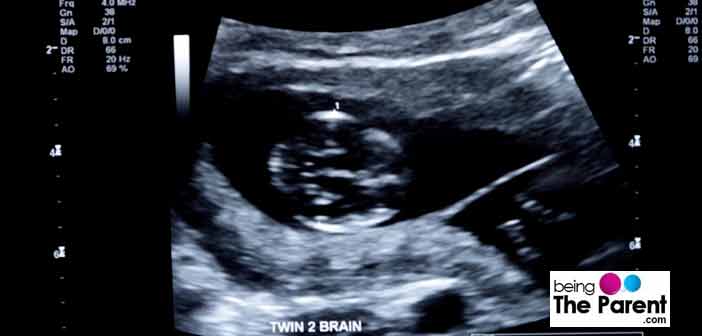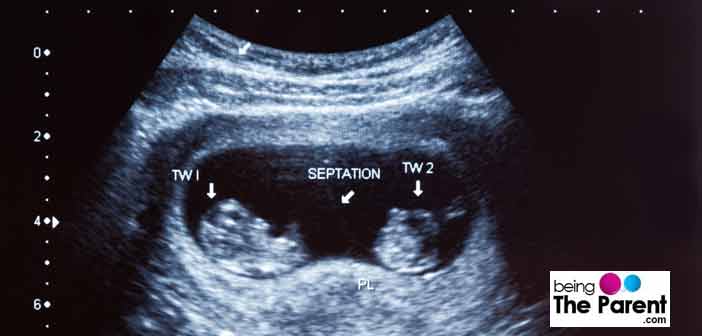
Vanishing twin syndrome, fetal resorption syndrome or twin embolisation syndrome is a condition where in a multi-gestation pregnancy, one fetus dies in the uterus followed by complete or partial reabsorption by the second twin. Sometimes instead of being completely absorbed, the non-viable fetus is found to be compressed by the other growing twin. It is seen as parchment-like flattened dead fetus- called fetus papyraceus.
What Is Vanishing Twin Syndrome?
The phenomenon of Vanishing Twins Syndrome (VTS) was not known till 1945. Prior to that women did not know anything about the syndrome. It was left undiagnosed unless it became evident by examining placenta after the birth by the doctor. Vanishing twin refers to the disappearance of one of the twins or multiples in the uterus sometime during pregnancy. This essentially translates into a miscarriage of one baby amongst the twins pr multiples.
Usually the demise of one twin occurs in the first trimester of pregnancy and less frequently in the later course of pregnancy. The early confirmation of twin pregnancy is quite easy when more than two embryonic sacs are seen in ultrasound instead of one. With the aid of ultrasound the heart beat of the fetuses can be seen as early as 6 weeks of pregnancy. The subsequent ultrasounds can reveal only one viable sac and one heart beat. It is here that diagnosis of vanishing twins is made. The remains of the fetus is abosorbed by the placenta of the mother, or by the other fetus in the womb. This mysterious disappearance of one of the fetus in a multi-gestation pregnancy is referred to as a vanishing twin syndrome.
What Causes Vanishing Twin Syndrome?
The true cause of vanishing twin syndrome is not known in most of the cases. Some believe that genetic abnormalities like extra chromosomes are responsible for the syndrome. The vanished fetus can also die due to improperly implanted placenta causing failure of major organs or even their complete absence. Commonly the non-viable twin is a blighted ovum that has failed to develop beyond the initial stages of embryogenesis. Placental and fetal examinations have revealed that the vanishing twin is not a sudden result, instead these chances are present in the initial development itself. Fertility treatments that involve planting of more eggs in the hope of 1 or 2 survivals also have a high risk of vanishing twin syndrome.
Common Signs and Symptoms Of Vanishing Twin
There are no definite symptoms however few expectant mothers experience symptoms identical to abortion or miscarriage. Some of the frequent symptoms are as listed under:
- Vaginal bleeding
- Mild cramp
- Pelvic pain and tenderness
- Decreasing level of hCG hormone as identified by blood tests
Span style=”color:#E60D36;”>These are not sure shot symptoms of dead fetus rather these symptoms are seen in miscarriages too. If you notice them immediately consult your doctor
Will My Pregnancy Progress Normally After Vanishing Twin?
In most pregnancies, the surviving twin develops normally and the pregnancy progresses, especially if the loss occurs in the first trimester of the pregnancy. The surviving fetus does not show any signs of having a womb mate. Sometimes, the fetus that survives absorbs the DNA of the other fetus. He becomes a person who has two sets of DNA, called as chimera.
If the loss occurs in the second or third trimester of pregnancy, there is a degree of increased risk to the surviving fetus and the further course of pregnancy.
Am I Vulnerable To Vanishing Twin Syndrome?
The incidences of vanishing twin syndrome have increased over the last few decades. The condition can be diagnosed by routine ultrasounds. They are common in about 20% to 30% of twin pregnancies. Women conceiving after 30 years of age are at the risk of this syndrome. Women who conceive with the aid of assisted fertility treatments are second most vulnerable ones.

Diagnosis of Vanishing Twin
In olden times, the diagnosis of a vanishing twin was made after examining the placenta post delivery. Nowadays, the diagnosis of the vanishing twin syndrome is chiefly made by ultrasonography. Since now the ultrasounds are of better resolution, increased cases of vanishing twin syndrome is observed. The ultrasounds facilitate the doctors in detecting vanishing twins also called ‘the shooting stars of the womb’ prior to their disappearance. Since the vanishing twin syndrome mostly occurs during the first trimester of pregnancy the expectant female continues her pregnancy with the other twin and not much intervention is needed. But if one of the twin demises during second or third trimester, the other twin can be at a threat of IUGR (intrauterine growth restriction) while the woman can experience preterm labor, hemorrhage or infection.
The mother experiences usual symptoms of pregnancy as she is pregnant with one of the twin and the dead fetus is reabsorbed by the mother’s body.
Are There Any Complications With Vanishing Twin Syndrome?
Usually no complications appear except spotting or vaginal bleeding if the fetus dies in the first trimester of pregnancy.
But serious complications are noticed if the fetal demise occurs during second or third trimester of pregnancy such as infection due to dead fetus, premature labor, hemorrhage and even the fetus papyraceus can also block mother’s cervix. In such a situation the viable fetus is delivered by Caesarean section.
Speaking about the viable twin, it is seen that it is not impacted due to embryo’s chromosomal makeup especially if the twins were fraternal or dizygotic twins.
What Is The Impact On The Viable Twin?
In most of the cases the viable twin is unaffected by the miscarriage of the first one. The surviving baby can be of low birth weight and can also suffer health hazards later in life. Remember if you have Rh Negative blood group, have Anti-D injection soon after the birth of the viable fetus This keeps you protected against any fetal abnormality in the future.
Loss and Grief
The condition is full of emotional upheaval and psychological upset for the mother as she experiences an absurd combination of relief due to the survival of one baby and anguish due to loss of her one baby. The agony of accepting the loss of one child and identity one’s identity as ‘could’ be parents of twins is very traumatizing and heart wrenching.
